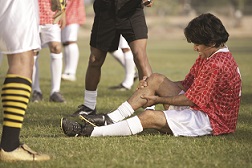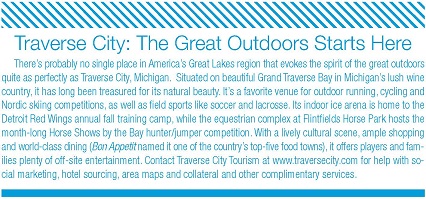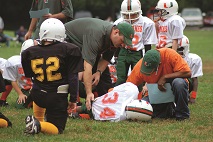
 Preparing for a youth sports event should always include investigating the purchase of a liability insurance policy. Unfortunate accidents on the field of play, in the stands or even in the parking lot may put amateur sports associations and tournaments at risk of financial loss.
Preparing for a youth sports event should always include investigating the purchase of a liability insurance policy. Unfortunate accidents on the field of play, in the stands or even in the parking lot may put amateur sports associations and tournaments at risk of financial loss.
What can youth organizations do to protect youth athletes, amateur sports organizations and tournament organizers beyond purchasing insurance? There is no substitute for best practices. Good risk management and business policies; inspection and maintenance of equipment; good record keeping and visible safety procedures all play an important role in reducing the risk of a lawsuit. Loss control and safety information is available through many sources including youth sports associations and other youth-oriented organizations; take advantage of as many educational opportunities as possible.
In addition to best practices, amateur sports associations and event organizers often require a signed waiver and release of liability before participating in sports activities. While this can be an effective means for defending a claim, it is not a failsafe method of protection.
 The law of minor waivers and releases varies from state to state as well as from jurisdiction to jurisdiction. However, unlike adults, minors are not legally capable of entering into a binding contract such as a waiver. Parents may sign a waiver on their child’s behalf; however, not all states allow parents to contractually waive a minor’s right to sue and the statute of limitations may extend for years until the participant reaches adulthood. This is very much an area of the law that is undergoing constant change.
The law of minor waivers and releases varies from state to state as well as from jurisdiction to jurisdiction. However, unlike adults, minors are not legally capable of entering into a binding contract such as a waiver. Parents may sign a waiver on their child’s behalf; however, not all states allow parents to contractually waive a minor’s right to sue and the statute of limitations may extend for years until the participant reaches adulthood. This is very much an area of the law that is undergoing constant change.
With that said, there are three conditions that should be met for waiver/releases:
1) the injury arises from stated risks including inherent risks or from the sports organization's ordinary negligence;
2) the waiver/release is properly drafted; and
3) it does not violate any state laws or public policy. In addition, the language in the wavier/release must meet state requirements. Other conditions that should be considered include:
Font size should be 10 point or higher. Many states set a minimum size standard for various legal documents and a court will not uphold a waiver if the print is too small.
The releasing language and parties should be clearly visible and identified. Include any corporate entities or individuals who should be included.
Avoid complicated and excessive language which may create confusion by the releaser and render the waiver invalid.
Clearly identify the word “Release” on the document in bold print. Include the specific word “Negligence”. Some states require waivers to provide language using the word negligence to be considered valid.
Include both a printed name and signature line to ensure the name of the person signing the waiver is clearly identifiable.
Maintain original signed documents for at least a period of one year after the expiration of your state’s statute of limitations.
 The laws surrounding the drafting and use of waiver/release documents vary from state to state and are complex. Consulting with legal counsel experienced in the use of waiver/releases in your specific jurisdiction is always recommended for the best protection possible.
The laws surrounding the drafting and use of waiver/release documents vary from state to state and are complex. Consulting with legal counsel experienced in the use of waiver/releases in your specific jurisdiction is always recommended for the best protection possible.
Since signed waivers won’t protect your organization under all circumstances, liability insurance is a must. Commercial general liability protects the insured against liability lawsuits or claims, from a third party, for bodily injury and property damage arising out of the insured’s premises and operations. Defending your organization against and paying for a liability claim is expensive. Liability insurance not only pays for damages you are held legally liable for but may also cover the cost of investigation and defense of claims, even if they are groundless. Always ask your insurance provider if defense costs are outside of your limits of coverage; if they are included, legal costs may quickly burn through your coverage limits. Commercial general liability may include:
Products-completed operations generally protects the organization from claims related to the manufacture or sale of products to the public; for sports organizations, this may include concession stands and the associated potential for food-related illness claims.
Personal and advertising injury covers an injury to a third-party brought about by the insured business advertising its goods and services, usually by copyright or trademark infringement or due to libel, slander or invasion of privacy.
Legal Liability to participants protects against bodily injury liability claims brought by persons participating in covered sports activities. Professional liability provides protection for claims arising out of the rendering or failure to render instruction relating to the sports activity.
Inland marine coverage, sometimes called equipment and contents coverage, provides coverage for direct loss or damage to sports equipment, field maintenance equipment, concession stand equipment and portable storage sheds.
Medical payments for participants coverage pays medical and dental expenses incurred by a participant when accidental injury occurs while participating in covered activities (this coverage is usually on an excess basis, after all other medical coverage available to the participant has been exhausted). This coverage may be included within the general liability policy or as a separate participant accident policy; make sure to review coverage options to verify where (or if) this insurance is provided in your insurance quote.

Sports organizations may also be able to purchase other optional coverage such as hosted tournament coverage or directors’ & officers’ liability coverage. Depending on the size and activities of the organization, additional liability coverage and other insurance products such as property, commercial auto, crime and excess liability may be needed. Working with a licensed insurance professional is always the best option when making decisions regarding complex insurance coverage.
When choosing an insurance provider, experience should always be a factor. Companies familiar with the unique risks associated with sports organizations and events will be able to accurately price coverage and more importantly, provide prompt and reliable claims handling services. You may also want to look for convenient services such as the ability to apply and purchase coverage online.
Purchasing the right type and amount of insurance provides peace of mind when preparing for your next event. Choose the right liability coverage for your sports organization and you’ll be able to focus on other details, knowing that you’ve got the coverage you need.

